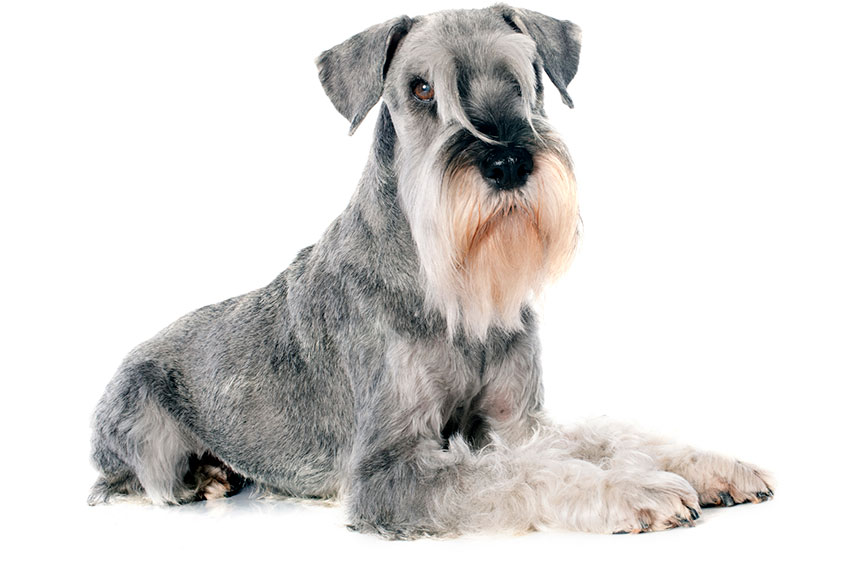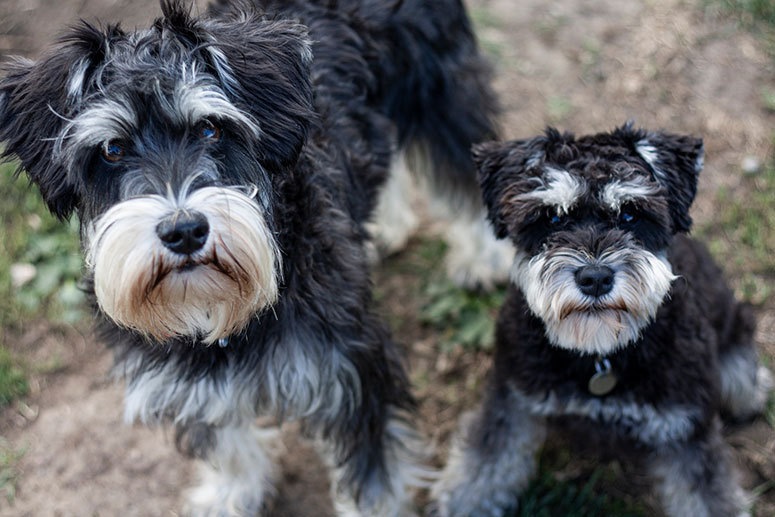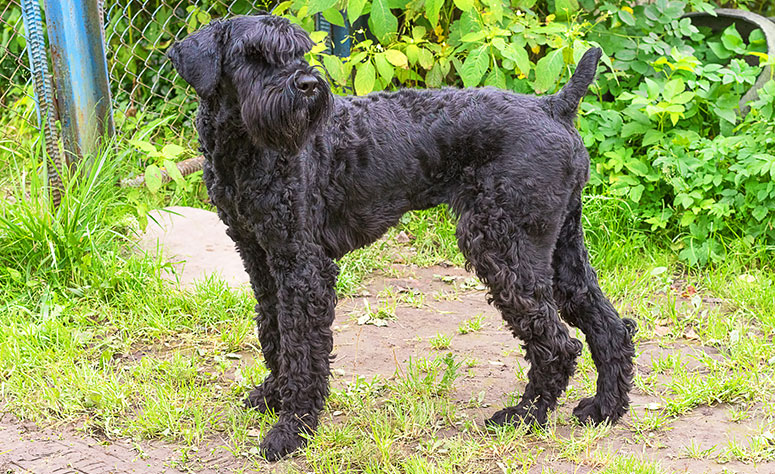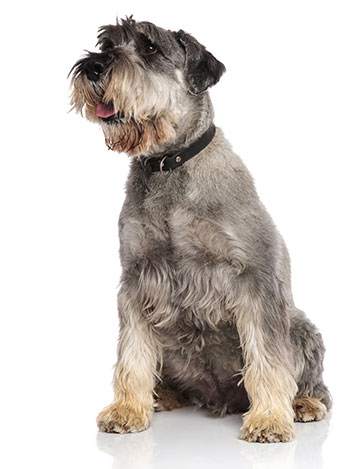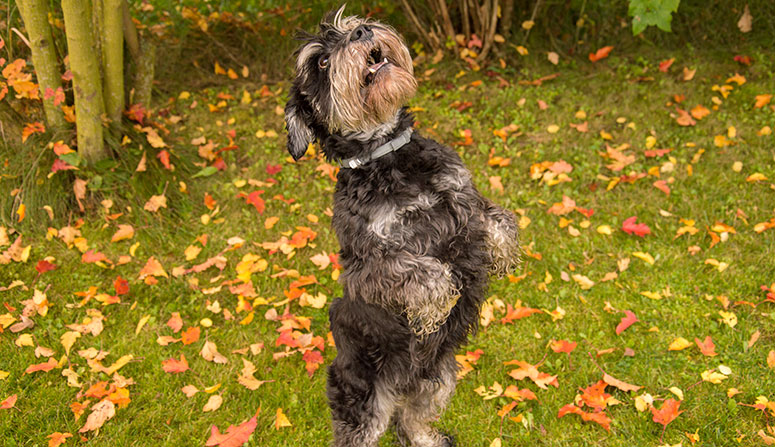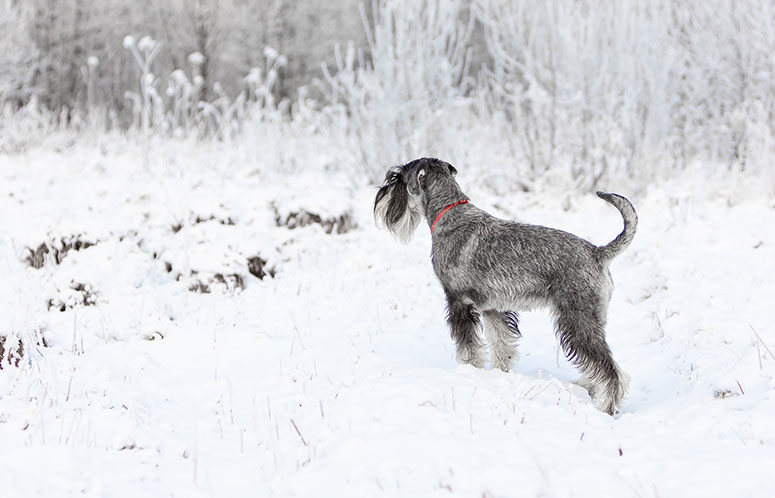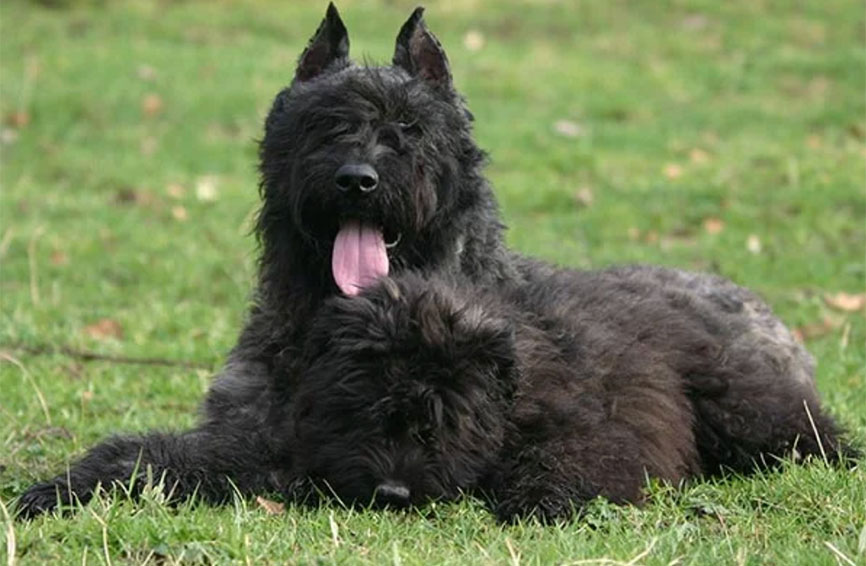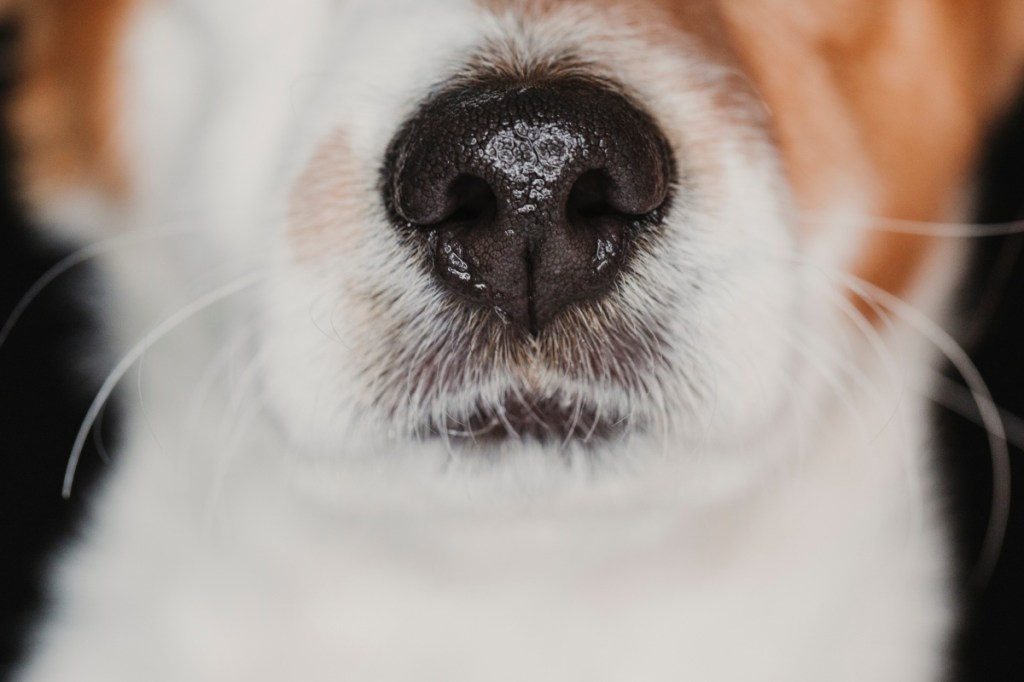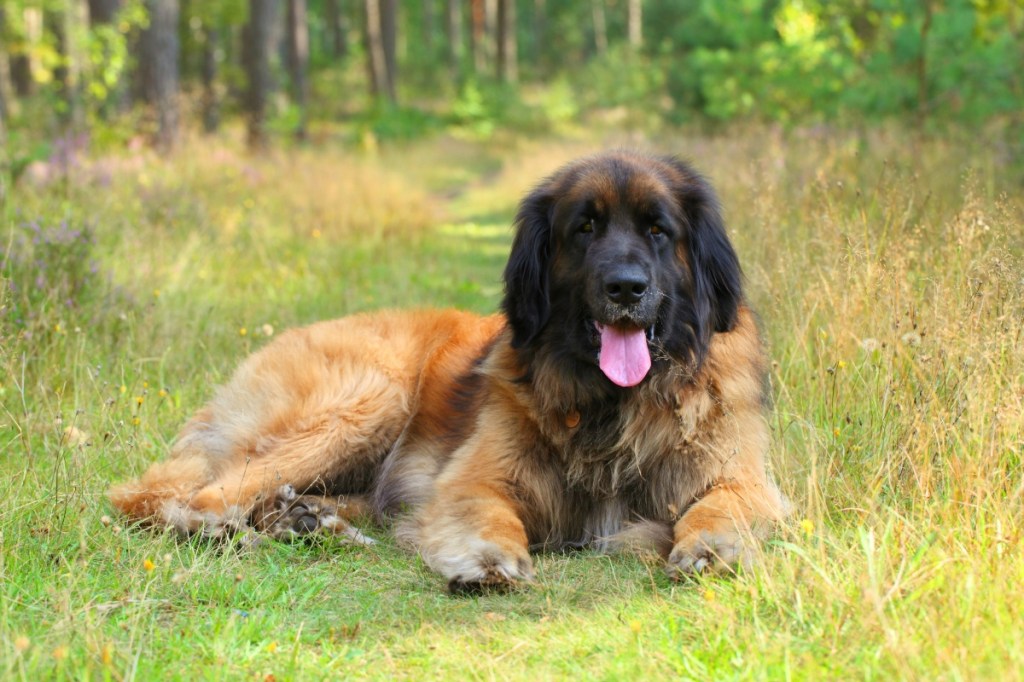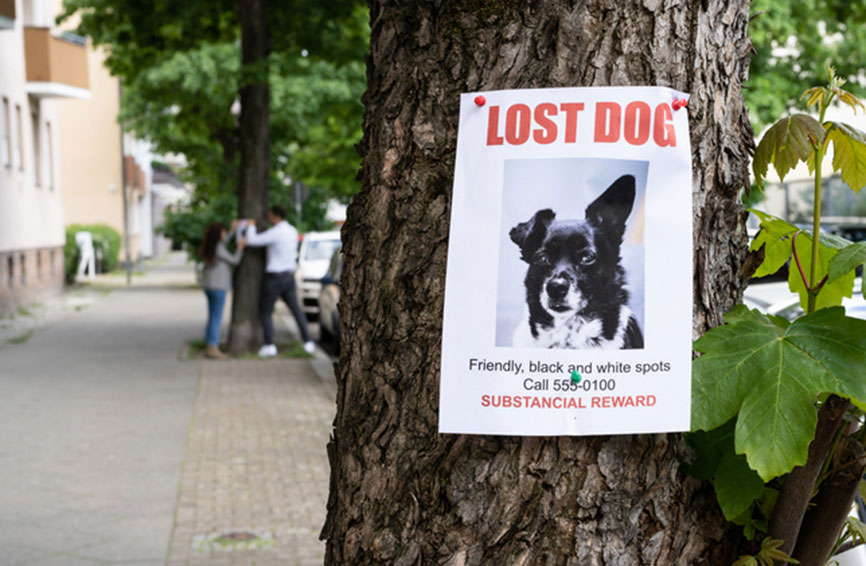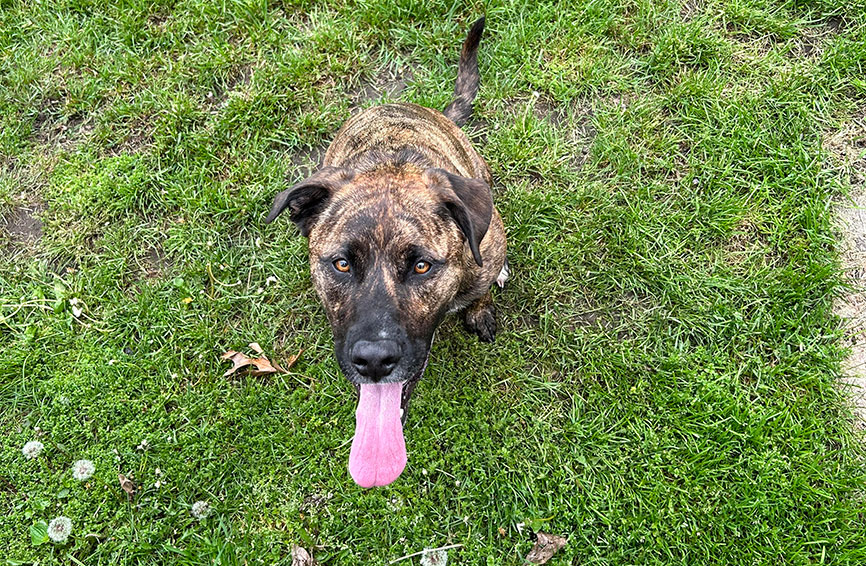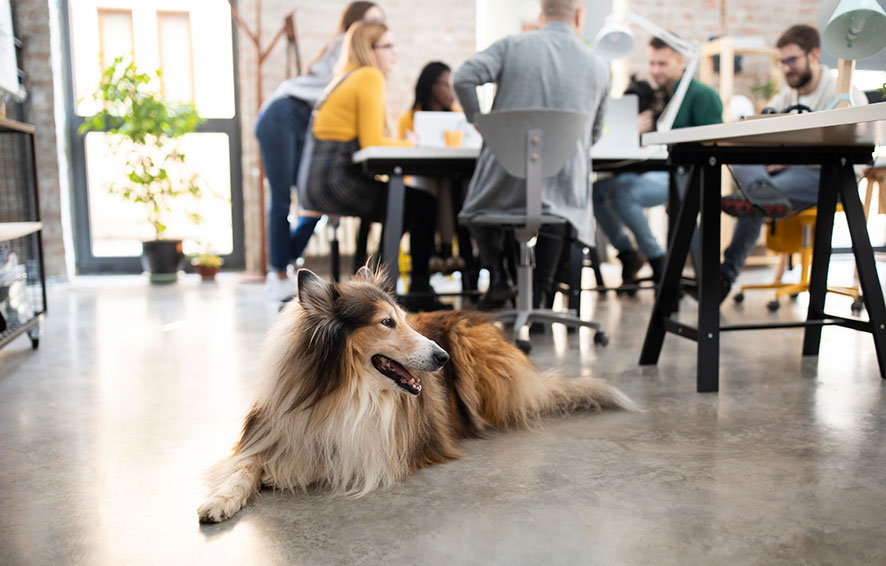Table of Contents
Introduction to Standard Schnauzers
Standard schnauzers are smart and fearless dogs of medium size, with origins in Germany. This dog breed is reliable but can be stubborn. It resembles the smaller miniature schnauzers and the larger giant schnauzers. A standard schnauzer may be the perfect companion for you if you’re looking for a dog that is full of energy and can go on adventures with you.
This Healthy Paws dog breed guide shares information about standard schnauzer dogs, including their size, temperament, physical characteristics, diet, potential health conditions, and care.
Size of Standard Schnauzers
Female standard schnauzers weigh 30 to 45 pounds and stand 17.5 to 18.5 inches tall when fully grown. Male adults are 35 to 50 pounds and 18.5 to 19.5 inches tall. Standard schnauzers are fully grown by about one year; however, females typically stop growing earlier than males.
Here’s how big you can expect your standard schnauzer to get as the dog grows from puppyhood to adulthood:
| Weight Chart | 6 months | 12 months | 18 months |
| Male standard schnauzers | 30 lbs. | 37.5 lbs. | 45 lbs. |
| Female standard schnauzers | 25 lbs. | 32.5 lbs. | 40 lbs. |
Characteristics of Standard Schnauzers
Standard schnauzers make excellent family dogs and have an almost aristocratic appearance. They are known for their high intelligence, guarding abilities, and stiff, wiry coats. The dogs have unique facial features, are athletic, and excel at tracking and herding. These versatile dogs have a lot to offer, and since they are eager to please and learn quickly, they can be good therapy dogs, too. They can be a good fit for families with older kids, but they should be closely supervised with young children.
As you get to know a standard schnauzer’s personality, here’s what you can expect based on the breed characteristics:
| Breed Characteristic | Level (High, Medium, Low) |
| Affectionate with People | Medium |
| Good with Kids | Medium |
| Good with Pets | Medium |
| Need for Exercise | High |
| Energy Level | High |
| Intelligence Level | High |
| Able to Be Trained | Medium |
| Amount of Barking | Low |
| Amount of Shedding | Low |
History of Standard Schnauzers
Although there are three different size classifications of schnauzers, the standard version is the original. The dogs were initially bred in Germany and are known as Mittelschnauzer (“medium schnauzer”). Farmers used these dogs to help with various things around the farm. The breed dates back to the Middle Ages and was first introduced in the farmlands of Bavaria, where they worked as herders, ratters, hunters, and guarders.
In the late 1800s, schnauzers became successful show dogs and were exhibited by breeders. Their presence in the U.S. dates back to at least 1900, and their popularity in America rose in the 1920s. The AKC parent club for the breed divided schnauzers into standard and miniature breed categories in 1933.
Schnauzers were used to carry dispatches and help relief workers during World War I. They have been used for police work and are in the AKC’s working group of dog breeds today.
Standard Schnauzer Standard Information
Standard schnauzers are judged at dog shows and competitions based on certain physical characteristics. These dogs are robust, have good muscle, and feature a rugged build and harsh coat. Pure standard schnauzers also have bristly mustaches and whiskers, arched eyebrows, and a square build.
Here is an overview of the breed standard information for standard schnauzers:
Head:
- Strong, elongated, and rectangular
- Medium-sized eyes that are dark brown and oval in shape
- Ears set high that are evenly shaped and of moderate thickness
- Strong muzzle that is parallel and equal in length to the topskull
- Moderately broad skull
- Large, black, and full nose
- White teeth that meet in a strong scissors bite
Neck, Topline, Body:
- Neck strong and of moderate thickness
- Topline has a slightly descending slope from the first vertebra of the withers
- Body is compact, strong, and short-coupled
- Chest is of medium width and with well-sprung ribs
Forequarters:
- Sloping shoulder blades that are strongly muscled
- Forelegs are straight and vertical without curvature
- Dewclaws may be removed
- Feet are small and compact
- Thick pads and strong, black nails
- Toes well-closed and arched
Hindquarters:
- Strongly muscled and balanced with the forequarters
- Broad thighs with well-bent stifles
- Dewclaws are generally removed
- Feet are the same as in the front
Coat:
- Hard, tight, wiry, and thick outercoat
- Soft and close undercoat
- Back hair measures from ¾ to 2 inches long
- Beard and eyebrows
- Leg hair is longer than body hair
Color:
- Salt and pepper or pure black
- Ideally, a gray undercoat on salt and pepper dogs
- Darker facial mask that goes with the shade of the coat color
Gait:
- Strong, free, and level gait with powerful and well-angulated hindquarters
- Back remains firm and level at a trot
Caring for Standard Schnauzers
With highly developed senses and a sense of fearlessness, standard schnauzers are dogs of great endurance and resilience against weather. They are high-spirited dogs that are reliable and a joy to care for. They are adaptable and can live equally good lives on a country farm, a city apartment, and a suburban home.
Here are some general tips for taking the best care of a standard schnauzer:
Best Living Environments:
- Apartments, houses, and farm properties are all okay
- Homes with a fenced yard since these dogs can jump high
- May do best as the only dog in the home
Type of Exercise:
- At least an hour of vigorous exercise daily
- Walk for 20 minutes at least three times a day or two 30-minute walks daily
- Fetch
- Frisbee
- Hiking
- Swimming
Mental Enrichment:
- Food rewards and praise for positive reinforcement
- Puzzle toys
- Nose work
Training Strategies:
- Tend to have a dominant personality
- Start training early to establish boundaries
- Socialize early, to reduce risk of aggressive behavior
- These dogs require patient and consistent pet parents
- Intelligent dogs that take to training well
Grooming Tips:
- These dogs require substantial grooming
- Brush the legs and beard daily to prevent tangles
- Wash the face after meals
- Hand-strip the coat every four to six months
- Closely trim the coat on the ears, neck, head, chest, stomach, and under the tail
- Brush teeth daily
- Trim nails once or twice monthly
Common Health Problems of Standard Schnauzers
Standard schnauzers are generally healthy dogs that live 13 to 16 years, on average. However, these dogs are prone to certain health issues because of their breeding and genetics.
These are some of the most common health issues that arise with standard schnauzers:
- Hip dysplasia
- Pulmonic stenosis
- Cataracts
- Retinal dysplasia
- Hypothyroidism
- Bladder stones
- Pancreatitis
- Cushing’s disease
- Hemophilia A, a blood clotting disorder
- Follicular dermatitis, a skin condition
Diet and Nutrition for Standard Schnauzers
Standard schnauzers need to eat between one and two cups of dry dog food daily when they are fully grown adults, depending on the quality and caloric density of the food. Most standard schnauzer pet parents stick to a twice-daily feeding schedule. Because this breed is known to eat quickly, consider a slow feeder bowl to help your dog’s digestion and prevent stomach upset.
Where to Adopt or Purchase Standard Schnauzers
The Standard Schnauzer Club of America is the national parent club for this breed, and its members are worldwide. The club provides resources related to breeding, care, training, and showing these dogs at competitions. You can view available litters of standard schnauzers on the club’s website.
The club also has the Standard Schnauzer Rescue Program, a volunteer-led nonprofit dedicated to rescuing and placing these dogs into loving homes. The rescue organization’s website has an application form and foster opportunities, too.
Related Breeds
Standard schnauzers share characteristics with other dog breeds, so you might be interested to learn about the various types of dogs available before deciding to adopt or purchase a new pet.
Below are some similar breeds to consider, some directly related to the standard schnauzer and others just comparable in terms of size and care:
- Miniature schnauzer
- Giant schnauzer
- German pinscher
- Kerry blue terrier
- Boxer
- Staffordshire bull terrier
- Welsh springer spaniel
Pet Insurance for Standard Schnauzers
Once you bring a standard schnauzer into your home, pet health insurance is one of the most important things to look into. With the rising costs of veterinary care, pet insurance is more valuable and necessary than ever. Our Healthy Paws plan has no maximum limits on claim payouts and allows you to visit any licensed vet you trust.
Healthy Paws is here for you whenever your standard schnauzer encounters a new accident or illness. Simply submit your vet bill to us via our mobile app or website to get reimbursement for your dog’s emergency care, cancer treatment, breed-specific and hereditary conditions, or alternative care.
Your online pet insurance is just a few clicks away when you provide a few details about your standard schnauzer. We look forward to helping you take the very best care of your pet and be prepared for any medical and financial burdens you experience with a standard schnauzer by your side.
